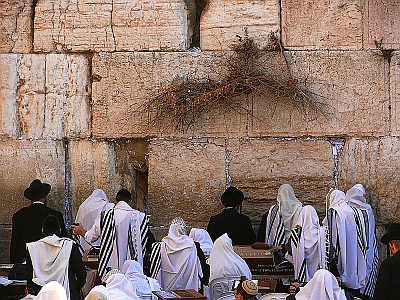In this special Sukkot reading, Moses asks that God’s presence would go with Israel, and God agrees.
Encouraged by this positive response, Moses also asks to see God’s glory. Once again, God graciously complies with his request and invites Moses to ascend Mount Sinai with two newly hewn stone tablets so that He can re-carve the Ten Commandments.
On the mountain, God reveals His to Moses in such a fearsome spectacle of power that God must protect Moses from being destroyed by it.
There is a place near Me where you can stand on a rock. When My glory passes by, I will put you in an opening in the rock. I will cover you with My hand until I have passed by. Then I will remove My hand. You will see My back. But My face must not be seen. (Exodus 33:21-23)
It’s clear that Moses, having experienced the power of the presence of God, understands that His presence is more than sufficient against any threat Israel might encounter inside or outside of the Promised Land.
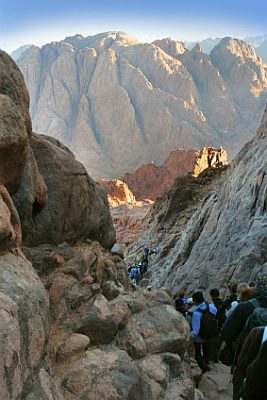 Tourists hike down Mount Sinai after enjoying the
Tourists hike down Mount Sinai after enjoying the
sun rise on top of the mountain where Moses
experienced the presence of God.
Gog and Magog: Challenging the Restoration of Israel
“This is what will happen in that day: When Gog attacks the land of Israel, My hot anger will be aroused.” (Ezekiel 38:18)
In the Haftarah (prophetic portion) for Shabbat Chol Hamoed Sukkot, the Hebrew prophet Ezekiel describes an End-Time scenario when formidable armies from the north, under the leadership of Gog, will challenge the restoration of Israel.
This invasion of Israel, wever, will end in the utter destruction of the forces of Gog, whose identity is somewhat obscure.
The forces that come against Israel will be so large in that day that Gog’s weaponry will provide fuel for Israel for seven years (Ezekiel 39:9).
They will not need to gather wood from the fields or cut it from the forests, because they will use the weapons for fuel. And they will plunder those who plundered them and loot those who looted them, declares the Sovereign LORD. (Ezekiel 39:10)
Moreover, so many soldie from Gog and Magog will die in this battle, that it will take seven months for Israel to bury them all and cleanse their land (Ezekiel 39:12).
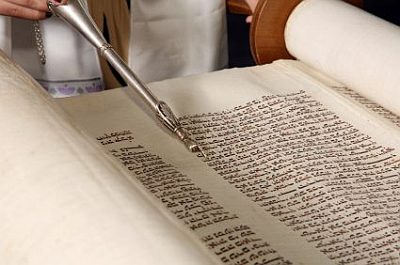 A yad (Torah pointer) is used when reading from the Torah scroll in order
A yad (Torah pointer) is used when reading from the Torah scroll in order
to protect the parchment and the cherished handwritten Word of God.
Sukkot and the Protective Covering of God
Why do we read about this end-time battle during Sukkot?
According to Rabbinic tradition, this war will be waged during the month of Tishrei, the month that the holiday of Sukkot (Feast of Tabernacles) falls within.
Interestingly enough, the war that is described in Ezekiel is similar to the war described in the 14th chapter of Zechariah, the Haftarah reading on the first day of Sukkot. And in Zechariah we learn that the Gentiles, who survive the war against Israel, will be required to keep Sukkot annually by coming up to the Holy City of Jerusalem to worship the Lord.
Then the survivors from all the nations that have attacked Jerusalem will go up year after year to worship the King, the Lord Almighty, and to celebrate the Feast of Tabernacles [Sukkot]. If any of the peoples of the earth do not go up to Jerusalem to worship the King, the Lord Almighty, they will have no rain. (Zechariah 14:16-17)
Psalm 27 presents a clear connection between Sukkot and God’s protection of Israel and those who trust in Him.
“For in the day of trouble He will conceal me in His tabernacle [sukkah]; In the secret place of His tent He will hide me; He will lift me up on a rock.” (Psalm 27:5)
The word translated as tabernacle in English is the Hebrew word sukkah (סכה). When evil threatens God’s people, He will hide them in His sukkah, inaccessible from the enemy on the rock of His presence.
Now that is a promise to trust in during these last days!
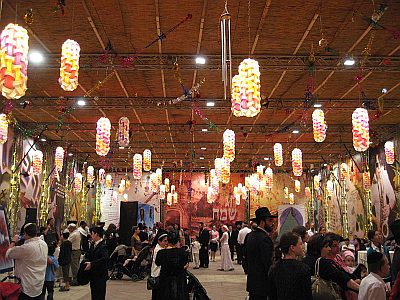 A festively arrayed public sukkah in Safra Square, Jerusalem
A festively arrayed public sukkah in Safra Square, Jerusalem
The Battle of Armageddon
“When the thousand years are over, Satan will be released from his prison, and will go out to deceive the nations in the four corners of the earth—Gog and Magog—to gather them for battle.” (Revelation 20:7-8)
Gog and Magog are also mentioned in the Brit Chadashah (New Testament) in connection with Armageddon, and the final battle between the forces of good and evil.
The word Armageddon is possibly derived from the city Meggido (meaning Invasion) mentioned many times in the Tanakh (Hebrew Scripture).
Tel Meggido is an elevation where many settlements existed and a Roman outpost was built to guard Via Maris (Way of the Sea), an important trade route connecting ancient Egypt with Mesopotamia.
Although there is debate over the origin and meaning of the word Armageddon, a symbolic rendering of the term is perhaps, hill of sorrows.
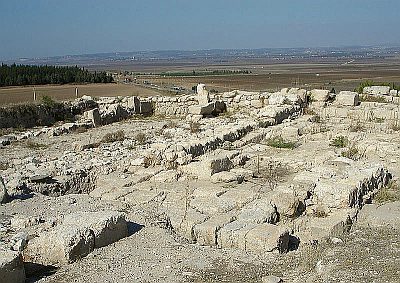
Ancient ruins atop Tel Meggido in Israel
Armageddon is mentioned only once in the Brit Chadashah (New Testament) in chapter 16 of the Book of Revelation.
They are spirits of demons performing miraculous signs, and they go out to the kings of the whole world, to gather them for the battle on the great day of God Almighty…. Then they gathered the kings together to the place that in Hebrew is called Armageddon. (Revelation 16:14, 16)
In this end-time scenario, we once again see Israel’s enemies mounting a war against Jerusalem. This time, however, we see the spiritual forces behind the rebellion against God.
“They had as king over them the angel of the Abyss, whose name in Hebrew is Abaddon, and in Greek, Apollyon.” (Revelation 9:11)
(The words Abaddon and Apollyon mean Destroyer.)
And this time, God pours out on all rebels the full extent of His judgment, including everlasting torment for Satan, the beast and the false prophet.
They marched across the breadth of the earth and surrounded the camp of God’s people, the city He loves. But fire came down from heaven and devoured them. And Satan, who deceived them, was thrown into the lake of burning sulfur, where the beast and the false prophet had been thrown. They will be tormented day and night forever and ever. (Revelation 20:9-10)
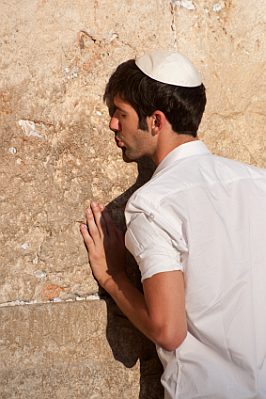 In a display of devotion to the God of Israel, a
In a display of devotion to the God of Israel, a
young Jewish man kisses the ancient Western
(Wailing) Wall in the Old City of Jerusalem.
With an Outstretched Arm
As we read how God will hurl His fury against Gog with pestilence and with blood, floods, giant hailstones, fire and brimstone, it’s easy to see from this Haftarah portion that God is furious with those who come against the Land of Israel (Ezekiel 38:22).
In fact, there are several parallels between God’s deliverance of Israel from Egypt long ago, and His future deliverance of Israel from Gog in the end times. In both we see that God saves and rescues Israel with a strong hand and with an outstretched arm.
The phrase “With a strong hand and an outstretched arm (בְּיָ֣ד חֲ֭זָקָה וּבִזְר֣וֹעַ נְטוּיָ֑ה)” has special meaning in Jewish tradition. It represents God using His power on behalf of His people. The ‘arm of the Lord’ also represents His salvation (Yeshua).
“You brought your people Israel out of Egypt with signs and wonders, by a mighty hand and an outstretched arm and with great terror.” (Jeremiah 32:21, see also Deuteronomy 4:34; 26:8; Exodus 6:6)
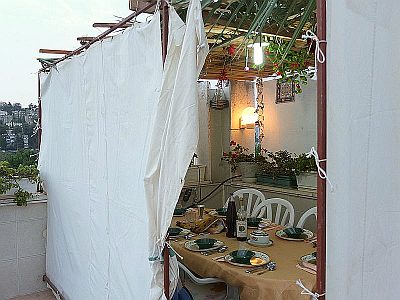
A beautiful sukkah atop a roof in Jerusalem beckons the family to dinner.
This special Sukkot Parasha reveals that God’s divine sheltering presence over Israel has not ended, but will continue past the end of this age.
God is not finished with the Jewish People and Israel. This is plainly evident when we consider how Bible Prophecy concerning Israel is being fulfilled during these end times.
The Brit Chadashah (New Covenant) also tells us that God’s plan to reach out to the nations through Israel did not end with the death and resurrection of Messiah, but continues to this day and will in the world to come.
“For if their casting Yeshua aside means reconciliation for the world, what their accepting Him mean? It will be life from the dead!” (Romans 11:15)
